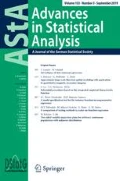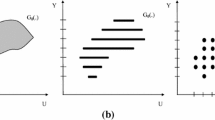Abstract
Weak identification is a well-known issue in the context of linear structural models. However, for probit models with endogenous explanatory variables, this problem has been little explored. In this paper, we study by simulating the behavior of the usual z-test and the LR test in the presence of weak identification. We find that the usual asymptotic z-test exhibits large level distortions (over-rejections under the null hypothesis). The magnitude of the level distortions depends heavily on the parameter value tested. In contrast, asymptotic LR tests do not over-reject and appear to be robust to weak identification.


Similar content being viewed by others
Notes
A further exception is Magnusson (2007), who considered in an early version of his paper the probit model with endogenous covariates as an example and found medium level distortions. However, in later versions of the working paper and in the published version (Magnusson 2010) the probit example was deleted.
For the ML estimation, the exogenous variable \(x_i\) was drawn from an N(0, 16) distribution.
This result is similar to that of Magnusson (2007).
We also tried the option "CUE" for the continuous updating estimator. However, we always got the error message "node stack overflow".
References
Abramitzky, R., Lavy, V.: How responsive is investment in schooling to changes in redistributive policies and in returns? Econometrica 82(4), 1241–1272 (2014)
Andrews, D.W., Cheng, X.: Maximum likelihood estimation and uniform inference with sporadic identification failure. J. Econom. 173(1), 36–56 (2013)
Andrews, D.W., Cheng, X.: GMM estimation and uniform subvector inference with possible identification failure. Econom. Theory 30(2), 287–333 (2014)
Beck, T., Lin, C., Ma, Y.: Why do firms evade taxes? The role of information sharing and financial sector outreach. J. Finance 69(2), 763–817 (2014)
Bijsterbosch, M., Dahlhaus, T.: Key features and determinants of credit-less recoveries. Empir. Econ. 49(4), 1245–1269 (2015)
Blundell, R.W., Smith, R.J.: Simultaneous microeconometric models with censored or qualitative dependent variables. In: Maddala, G.S., Rao, C.R., Vinod, H.D. (eds.) Handbook of Statistics. Econometrics, vol. 11, pp. 117–143. North Holland, Amsterdam (1993)
Bouoiyour, J., Miftah, A., Mouhoud, E.M.: Education, male gender preference and migrants’ remittances: interactions in rural Morocco. Econ. Model. 57, 324–331 (2016)
Chaussé, P.: Computing generalized method of moments and generalized empirical likelihood with R. J. Stat. Softw. 34(11), 1–35 (2010)
Cornelli, F., Kominek, Z., Ljungqvist, A.: Monitoring managers: Does it matter? J. Finance 68(2), 431–481 (2013)
Croushore, D., Marsten, K.: Reassessing the relative power of the yield spread in forecasting recessions. J. Appl. Econom. 31(6), 1183–1191 (2016)
Dufour, J.M.: Some impossibility theorems in econometrics with applications to structural and dynamic models. Econometrica 65(6), 1365–1387 (1997)
Dufour, J.M.: Identification, weak instruments, and statistical inference in econometrics. Can. J. Econ./Revue canadienne d’économique 36(4), 767–808 (2003)
Dufour, J.M.: Monte Carlo tests with nuisance parameters: a general approach to finite-sample inference and nonstandard asymptotics. J. Econom. 133(2), 443–477 (2006)
Engelhardt, G.V., Eriksen, M.D., Gale, W.G., Mills, G.B.: What are the social benefits of homeownership? Experimental evidence for low-income households. J. Urban Econ. 67(3), 249–258 (2010)
Esaka, T.: De facto exchange rate regimes and currency crises: Are pegged regimes with capital account liberalization really more prone to speculative attacks? J. Bank. Finance 34(6), 1109–1128 (2010)
Fitzenberger, B., Kohn, K., Wang, Q.: The erosion of union membership in Germany: determinants, densities, decompositions. J. Popul. Econ. 24(1), 141–165 (2011)
Greene, W.H.: Econometric Analysis, 6th edn. Prentice Hall, Upper Saddle River (2008)
Haider, A., Jahangir, A.: La familia—how trust towards family decreases female labor force participation. J. Labor Res. 38(1), 122–144 (2017)
Hao, L., Ng, E.C.: Predicting Canadian recessions using dynamic probit modelling approaches. Can. J. Econ./Revue canadienne d’économique 44(4), 1297–1330 (2011)
Harris, D., Mátyás, L.: Introduction to the generalized method of moments estimation. In: Mátyás, L. (ed.) Generalized Method of Moments Estimation, pp. 3–30. Cambridge University Press, Cambridge (1999)
Hlaing, K.P., Pourjalali, H.: Economic reasons for reporting property, plant, and equipment at fair market value by foreign cross-listed firms in the United States. J. Account. Audit. Finance 27(4), 557–576 (2012)
Horvath, R., Katuscakova, D.: Transparency and trust: the case of the European central bank. Appl. Econ. 48(57), 5625–5638 (2016)
Khanna, V., Kim, E.H., Lu, Y.: CEO connectedness and corporate fraud. J. Finance 70(3), 1203–1252 (2015)
Kleibergen, F.: Testing parameters in GMM without assuming that they are identified. Econometrica 73(4), 1103–1123 (2005)
Litchfield, J., Reilly, B., Veneziani, M.: An analysis of life satisfaction in Albania: an heteroscedastic ordered probit model approach. J. Econ. Behav. Organ. 81(3), 731–741 (2012)
Magnusson, L.M.: Weak instruments robust tests for limited dependent variable models. Technical report, working paper, Brown University (RI) (2007)
Magnusson, L.M.: Inference in limited dependent variable models robust to weak identification. Econom. J. 13(3), S56–S79 (2010)
Massa, M., Zhang, L.: Monetary policy and regional availability of debt financing. J. Monetary Econ. 60(4), 439–458 (2013)
R Core Team: R: a language and environment for statistical computing. R Foundation for Statistical Computing, Vienna https://www.R-project.org/ (2016)
Stock, J.H., Wright, J.H., Yogo, M.: A survey of weak instruments and weak identification in generalized method of moments. J. Bus. Econ. Stat. 20(4), 518–529 (2002)
Wen, J.F., Gordon, D.V.: An empirical model of tax convexity and self-employment. Rev. Econ. Stat. 96(3), 471–482 (2014)
Wilde, J.: A note on GMM estimation of probit models with endogenous regressors. Stat. Pap. 49(3), 471–484 (2008)
Author information
Authors and Affiliations
Corresponding author
Additional information
The authors thank Leandro Magnusson and two anonymous referees for several useful comments, and Dietrich Trenkler and Sebastian Veldhuis for valuable assistance. This work was supported by the William Dow Chair in Political Economy (McGill University), the Bank of Canada (Research Fellowship), the Toulouse School of Economics (Pierre-de-Fermat Chair of excellence), the Universitad Carlos III de Madrid (Banco Santander de Madrid Chair of excellence), a Guggenheim Fellowship, a Konrad-Adenauer Fellowship (Alexander-von-Humboldt Foundation, Germany), the Natural Sciences and Engineering Research Council of Canada, the Social Sciences and Humanities Research Council of Canada, and the Fonds de recherche sur la société et la culture (Québec).
Appendix: Simulation results for model (5) with \(\beta _{11}=\pi _{21}= 0\)
Rights and permissions
About this article
Cite this article
Dufour, JM., Wilde, J. Weak identification in probit models with endogenous covariates. AStA Adv Stat Anal 102, 611–631 (2018). https://doi.org/10.1007/s10182-018-0325-8
Received:
Accepted:
Published:
Issue Date:
DOI: https://doi.org/10.1007/s10182-018-0325-8




